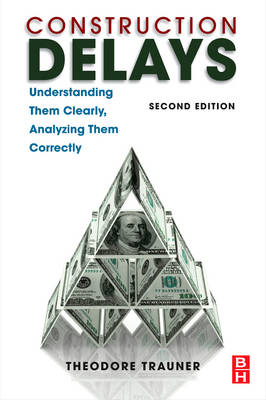
Construction Delays
Butterworth-Heinemann Ltd (Verlag)
978-1-85617-677-4 (ISBN)
- Titel erscheint in neuer Auflage
- Artikel merken
Delays in construction projects are frequently expensive, since there is usually a construction loan involved which charges interest, management staff dedicated to the project whose costs are time dependent, and ongoing inflation in wage and material prices. Many techniques are used to analyze delays. Some of these methods have inherent weaknesses and should be avoided. This book points out the shortcomings of these faulty methods and explains how a delay analysis should be performed. It then describes specifically how the analysis is done with CPM schedules. A explanation of delays and delay damages, presented in a straightforward, accessible manner, should be useful to public and private owners, construction managers, general contractors, subcontractors, designers, suppliers, and attorneys whose work involves them in the construction industry. The discussion will include subtleties of the process, such as shifts in the critical path, and non-critical delays. The subject of damages is covered in detail, including the major categories of extended field overhead and unabsorbed home office overhead. Likewise, the damages suffered by the owner, either actual or liquidated, are also explained. Finally, a chapter is devoted to managing the risk of delays and time extensions from the viewpoints of the various parties to a construction project. A discussion of early completion schedules and constructive acceleration is also included. In this new ediion, all chapters are updated to reflect the changes in the construction field since the first edition published over l6 years ago. The Second Edition includes over 40% more information such as new methods for analyzing delays with examples of the proper approach. The author also includes a new chapter on risk managment which focuses on the delay-related risks of the various parties in a construction project.
A nationally recognized construction expert in scheduling, construction management, cost overruns/damages, construction means and methods, and delay and inefficiency analysis, Ted has either managed construction or evaluated problems on virtually every type of project including transportation, water/wastewater treatment, power, process and manufacturing, medical, educational, commercial, correctional, hotels, condominiums, residential housing, and athletic facilities.
ForewordAcknowledgementsIntroduction to Second EditionChapter 1: Project SchedulingThe Project ScheduleThe Purpose of a Project ScheduleTypes of Project SchedulesWhat is the Contemporaneous Schedule?What is the Critical Path?What is Float?Who Owns Float?Reviewing and Approving the Project ScheduleEarly Completion SchedulesChapter 2: Types of Construction DelaysWhat is a delay?Critical versus Non-Critical DelaysExcusable versus Non-Excusable DelaysCompensable versus Non-Compensable DelaysConcurrent DelaysChapter 3: Measuring Delays'the BasicsThe Importance of PerspectiveUse the Contemporaneous Schedule to Measure DelayDo Not Create Schedules After-the-Fact to Measure DelaysWhat to Do When there is No ScheduleWhat is the As-Planned Schedule?What is As-Built Information?The Importance of the Critical PathThe General Method for Analyzing a Schedule for DelaysThe Unique Position of SubcontractorsChapter 4: Delay Analysis Using Bar Chart SchedulesBar Chart Schedules versus CPM SchedulesDefining the Critical PathQuantifying Delays Using Bar Chart SchedulesChapter 4 ExampleChapter 5: Delay Analysis Using CPM SchedulesThe Advantages of Using CPM Schedules to Measure DelaysIdentifying the As-Planned ScheduleCorrecting versus Leaving ErrorsIdentifying Schedule Updates for the Purpose of Measuring DelaysUse of Scheduling Software and Other Software Tools in the Quantification of DelaysChapter 5 ExamplesChapter 6: Delay Analysis When there is No ScheduleUse of Contemporaneous Documents for Sequence and TimingUsing an As-Built Analysis to Quantify DelaysChapter 7: Other Analysis Techniques'Their Strengths and WeaknessesUsing Fragnets to Quantify DelaysWindows TechniquesImpacted As-Planned AnalysesCollapsed As-Built AnalysesAnalyses Based on DollarsBut-For Schedules, Analyses, and ArgumentsChapter 8: An Owner's Damages Due to DelayLiquidated DamagesActual DamagesChapter 9: A Contractor's Damages Due to DelayGeneral Guidelines for the Presentation and Recovery of DamagesTypes of Delay DamagesEscalation of Labor CostsEquipment CostsMaterial CostsOther Delay CostsChapter 10: Home Office OverheadWhat is Home Office Overhead?Effects of Delays on Home Office CostsEichleay FormulaCanadian MethodCalculation Using Actual RecordsNet Present Value AnalysisChapter 11: Inefficiency Caused by DelayWhat is Inefficiency?Ways That Delay Can Lead to InefficienciesQuantifying InefficiencyQuantifying the Costs of InefficiencyChapter 12: AccelerationWhat is Acceleration?Why is a Project Accelerated?Constructive AccelerationHow is a Project Accelerated?Quantification of the Time Savings Associated with AccelerationQuantifying the Costs of AccelerationChapter 13: Other Categories of Delay DamagesDamages Associated with Non-Critical DelaysConsulting and Legal CostsLost Profits/Opportunity CostsChapter 14: Determining Responsibility for DelayContract RequirementsGathering the FactsEvaluating ResponsibilityWeather DelaysChapter 15: Risk ManagementOwner's ConsiderationsConstruction Manager's ConsiderationsGeneral Contractor's ConsiderationsSubcontractor's and Supplier's ConsiderationsDesign Consultant's ConsiderationsReal Time Claims Management
| Erscheint lt. Verlag | 3.6.2009 |
|---|---|
| Verlagsort | Oxford |
| Sprache | englisch |
| Maße | 152 x 229 mm |
| Gewicht | 600 g |
| Themenwelt | Technik ► Bauwesen |
| ISBN-10 | 1-85617-677-0 / 1856176770 |
| ISBN-13 | 978-1-85617-677-4 / 9781856176774 |
| Zustand | Neuware |
| Informationen gemäß Produktsicherheitsverordnung (GPSR) | |
| Haben Sie eine Frage zum Produkt? |
aus dem Bereich



